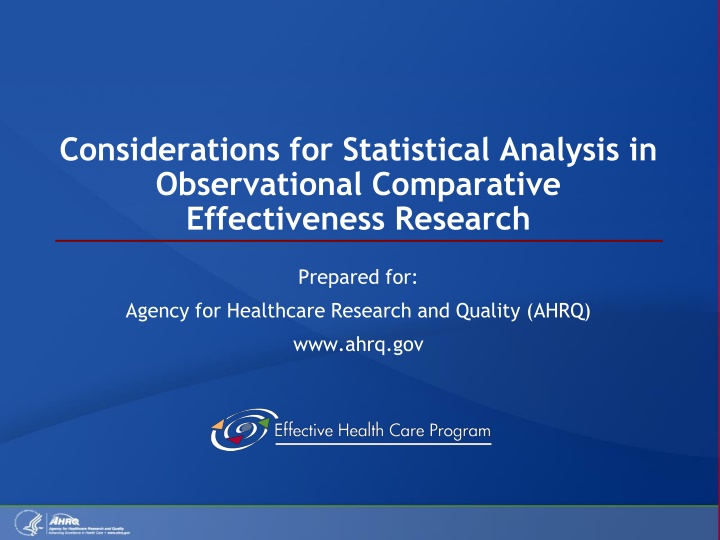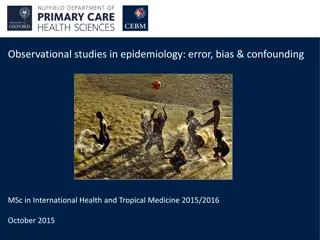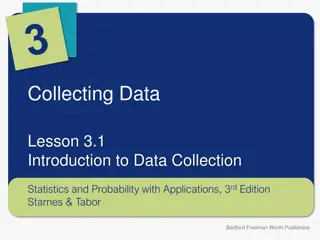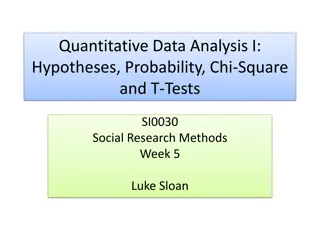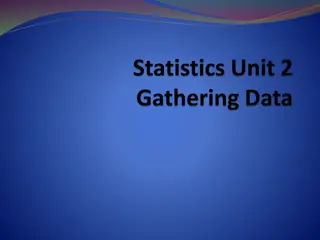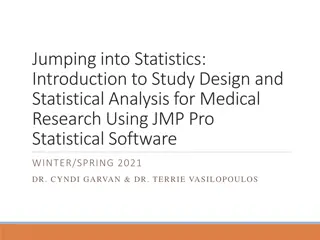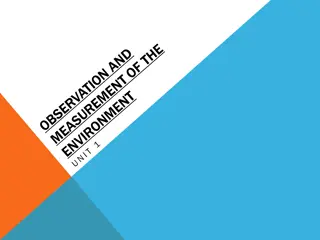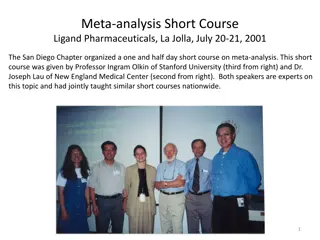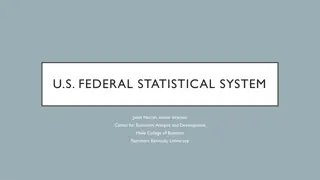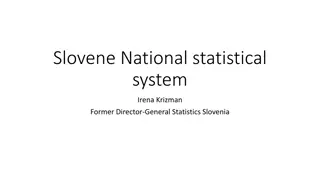Considerations for Statistical Analysis in Observational Research
Careful statistical analysis is crucial in observational comparative effectiveness research to address confounding factors. This involves descriptive statistics, unadjusted analyses, traditional regression models, propensity scores, instrumental variables, and more.
Download Presentation

Please find below an Image/Link to download the presentation.
The content on the website is provided AS IS for your information and personal use only. It may not be sold, licensed, or shared on other websites without obtaining consent from the author.If you encounter any issues during the download, it is possible that the publisher has removed the file from their server.
You are allowed to download the files provided on this website for personal or commercial use, subject to the condition that they are used lawfully. All files are the property of their respective owners.
The content on the website is provided AS IS for your information and personal use only. It may not be sold, licensed, or shared on other websites without obtaining consent from the author.
E N D
Presentation Transcript
Considerations for Statistical Analysis in Observational Comparative Effectiveness Research Prepared for: Agency for Healthcare Research and Quality (AHRQ) www.ahrq.gov
Outline of Material This presentation will: Describe the key variables of interest with regard to factors that determine appropriate statistical analysis Propose descriptive analysis or graph according to treatment group Propose the model that will be used for primary and secondary analytical objectives
Introduction When observational data are used in comparative effectiveness research, careful and often complex analytic strategies are required to adjust for confounding. Statistical considerations Descriptive Statistics/Unadjusted Analyses Traditional Multiple Regression Model Selection Model Assumptions Propensity Scores/Disease Risk Scores Instrumental Variables Missing Data Considerations Time-Varying Exposures/Covariates
Descriptive Statistics and Unadjusted Analysis Descriptive statistics Continuous variables: measures of range, dispersion, and central tendency Categorical variables: frequency (n) and percentage Data distributions: Kaplan-Meier plots Unadjusted analysis Conducted to identify covariates associated with the exposure and/or study outcome (e.g., t-test) Can provide a broad picture of study subject characteristics
Adjusted Analysis Traditional multivariable regression Control for potential confounding variables in the estimation of treatment effects Useful when there is a sufficient number of outcome events per covariate and exposure is not infrequent If exposure is common and the outcome rare, consider propensity scores. If exposure is infrequent, consider disease risk scores.
Model Selection Number of Followup Measures and Time Intervals Repeated measure, fixed intervals Repeated measure, variable intervals Single measure Outcome measure Clustering (e.g., multisite study) No clustering Multilevel (mixed) logistic regression, GLMM, GEE, conditional logistic regression Repeated measures ANOVA (MANOVA), GLMM, GEE Dichotomous Logistic regression GLMM, GEE Repeated measures ANOVA (MANOVA), GLMM, GEE Multilevel (mixed) linear regression, GLMM, GEE Continuous Linear regression GLMM, GEE Variance-adjusted Cox model or shared frailty model Cox proportional hazards regression Time to event Time to event (aggregate or count data) Multilevel (mixed) Poisson regression Poisson regression
Propensity Scores Propensity scores measure the probability of receiving treatment (or exposure) conditional on observed covariates. Propensity scores are favorable in studies with a common exposure and rare or multiple outcomes. They can be used in subclassification or stratification, matching, and weighting. They include covariates that are true confounders or at least related to study outcome.
Disease Risk Scores Disease risk scores (DRSs) measure the estimated probability or rate of outcome occurrence as a function of covariates. Estimation approaches: Fit regression model for entire cohort, adjusting for exposure Fit regression model for unexposed/referent group Compute fitted values assuming unexposed/referent group for all study subjects DRSs are favorable in studies having a common outcome and rare exposure. DRSs are useful for effect modification by disease risk.
Instrumental Variables Instrumental variables are measures that are causally related to exposure but unrelated to outcome and study covariates. They are useful for adjusting for potential unmeasured confounders. However, it may be difficult to identify a high- quality instrument. They can be used in conjunction with traditional multiple regression and propensity score matching.
Missing Data Considerations Observational studies commonly have missing data. Missingness can be characterized by using exploratory data analyses. Complete-case analysis for subjects with no missing data: Can reduce sample size, limiting efficiency Can result in potential bias if missingness is differential between groups Imputation for missing completely at random or missing at random
Time-Varying Exposures/Covariates Time-dependent Cox regression models can account for time-varying exposures and covariates. However, difficult issues arise when both treatment and confounding variables vary over time. Inverse-probability-of-treatment weighting can be used to estimate a marginal structure model. This approach is a generalization of propensity score weighting to the time-varying treatment context. Intent-to-treat analysis can be conducted in which exposure status is assumed throughout followup when treatment adherence is low.
Conclusion Observational comparative effectiveness studies are often strongly affected by confounding. Thoughtful application of statistical approaches can adjust for confounding and improve causal inference. An appropriate analytical technique is based on assumptions. Consider the effect of missing data on analyses. Sensitivity analyses can address residual confounding.
Summary Checklist (1 of 3) Guidance Key Considerations Describe the key variables of interest with regard to factors that determine appropriate statistical analysis Independent variables (when are they measured, fixed, or time-varying; e.g., exposures, confounders, effect modifiers) Dependent variables or outcomes (continuous or categorical, single or repeated measure, and time to event) State if there will be a multilevel analysis (e.g., looking at effects of both practice-level and patient-level characteristics on outcome)
Summary Checklist (2 of 3) Guidance Key Considerations Propose descriptive analysis or graph according to treatment group Should include the available numbers per group, n missing for all key covariates, and distributions or graphs that are needed to decide if transformation of data is needed or determine an accurate functional form of the final model Should include all potential confounders and effect modifiers to assess initial covariate balance by study group
Summary Checklist (3 of 3) Guidance Key Considerations Propose the model that will be used for primary and secondary analytical objectives Should take into account the design (independent vs. dependent observations, matched, repeated measurement, clustered), objectives, functional form of model, fixed/time-varying followup period, fixed and time-varying exposure and other covariates, assessment of effect modification/heterogeneity, type of outcome variables (categorical, ordinal, or continuous), censored data, and the degree of rarity of outcome and exposure Should propose a suitable approach for adjusting for confounding (e.g., multiple regression model, propensity scores, instrumental variables [could be secondary or main analysis])
